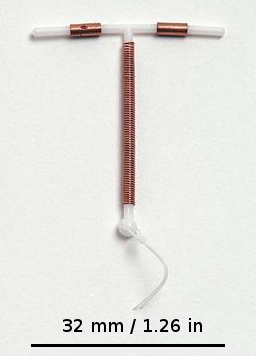Long-acting reversible contraceptives
(Redirected from Long-acting reversible contraception)
Contraceptives that provide effective contraception for an extended period without requiring user action
Long-acting reversible contraceptives (LARCs) are a type of birth control that provide effective contraception for an extended period without requiring user action. They include intrauterine devices (IUDs) and subdermal contraceptive implants. LARCs are highly effective, with failure rates of less than 1% per year, and are considered among the most effective forms of reversible contraception.
Types of LARCs[edit | edit source]
Intrauterine Devices (IUDs)[edit | edit source]
IUDs are small, T-shaped devices that are inserted into the uterus by a healthcare provider. There are two main types of IUDs:
- Copper IUDs: These release copper ions, which are toxic to sperm, thus preventing fertilization. They can remain effective for up to 10 years.
- Hormonal IUDs: These release progestin, which thickens cervical mucus and inhibits sperm movement. They can remain effective for 3 to 7 years, depending on the brand.
Subdermal Contraceptive Implants[edit | edit source]
Subdermal implants are small rods inserted under the skin of the upper arm. They release progestin, which prevents ovulation and thickens cervical mucus. Implants are effective for up to 3 years.
Mechanism of Action[edit | edit source]
LARCs work primarily by preventing fertilization. Copper IUDs create an inflammatory reaction in the uterus that is toxic to sperm and eggs. Hormonal IUDs and implants release progestin, which prevents ovulation, thickens cervical mucus, and thins the uterine lining, making it less suitable for implantation.
Advantages[edit | edit source]
- High Efficacy: LARCs have a failure rate of less than 1% per year, making them more effective than most other forms of contraception.
- Long-term Protection: Once inserted, LARCs provide continuous protection for several years.
- Reversibility: Fertility typically returns quickly after removal of the device.
- Low Maintenance: LARCs do not require daily action, unlike oral contraceptives.
Disadvantages[edit | edit source]
- Insertion and Removal: Both IUDs and implants require a healthcare provider for insertion and removal.
- Side Effects: Some users may experience side effects such as irregular bleeding, especially with hormonal IUDs and implants.
- Initial Cost: The upfront cost can be higher than other contraceptive methods, although they are cost-effective over time.
Use and Accessibility[edit | edit source]
LARCs are used worldwide and are recommended by many health organizations due to their effectiveness and safety. However, access can be limited by factors such as cost, availability of trained providers, and cultural acceptance.
Related pages[edit | edit source]
Search WikiMD
Ad.Tired of being Overweight? Try W8MD's physician weight loss program.
Semaglutide (Ozempic / Wegovy and Tirzepatide (Mounjaro / Zepbound) available.
Advertise on WikiMD
|
WikiMD's Wellness Encyclopedia |
| Let Food Be Thy Medicine Medicine Thy Food - Hippocrates |
Translate this page: - East Asian
中文,
日本,
한국어,
South Asian
हिन्दी,
தமிழ்,
తెలుగు,
Urdu,
ಕನ್ನಡ,
Southeast Asian
Indonesian,
Vietnamese,
Thai,
မြန်မာဘာသာ,
বাংলা
European
español,
Deutsch,
français,
Greek,
português do Brasil,
polski,
română,
русский,
Nederlands,
norsk,
svenska,
suomi,
Italian
Middle Eastern & African
عربى,
Turkish,
Persian,
Hebrew,
Afrikaans,
isiZulu,
Kiswahili,
Other
Bulgarian,
Hungarian,
Czech,
Swedish,
മലയാളം,
मराठी,
ਪੰਜਾਬੀ,
ગુજરાતી,
Portuguese,
Ukrainian
Medical Disclaimer: WikiMD is not a substitute for professional medical advice. The information on WikiMD is provided as an information resource only, may be incorrect, outdated or misleading, and is not to be used or relied on for any diagnostic or treatment purposes. Please consult your health care provider before making any healthcare decisions or for guidance about a specific medical condition. WikiMD expressly disclaims responsibility, and shall have no liability, for any damages, loss, injury, or liability whatsoever suffered as a result of your reliance on the information contained in this site. By visiting this site you agree to the foregoing terms and conditions, which may from time to time be changed or supplemented by WikiMD. If you do not agree to the foregoing terms and conditions, you should not enter or use this site. See full disclaimer.
Credits:Most images are courtesy of Wikimedia commons, and templates, categories Wikipedia, licensed under CC BY SA or similar.
Contributors: Prab R. Tumpati, MD

